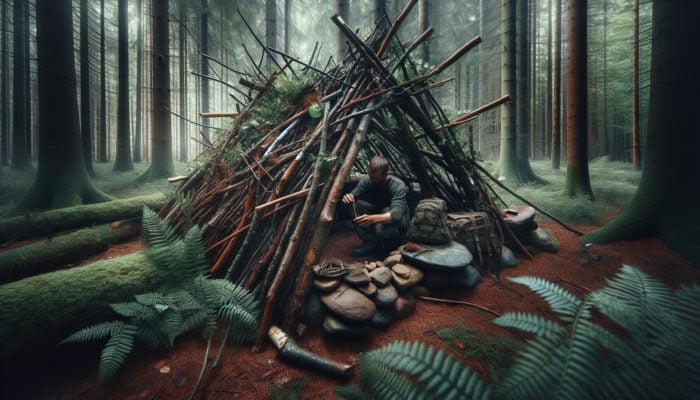Mastering the Art of Crafting Essential Survival Tools
Skillfully Crafting Functional Knives for Survival

Homemade Survival Tools: The ability to create a functional knife is a vital skill within the domain of homemade survival tools. A knife is not merely a cutting instrument; it serves a multitude of purposes, including slicing rope, preparing food, and executing intricate tasks necessary for survival in the wilderness. The process of crafting a knife can be accomplished with materials that are often readily available in various environments. A commonly adopted method involves locating a robust piece of metal, such as an old saw blade or a metal file, which can be repurposed for a new purpose. The initial step in this process involves shaping the metal into a blade, which is achieved through techniques such as forging or grinding to attain the desired sharpness and design.
Following the creation of the blade, the subsequent critical step is to construct a handle. This can be accomplished using materials like wood, bone, or even resilient plastic that can be securely moulded. To reinforce the bond between the blade and the handle, one can employ glue or wrap the joint with cordage to ensure a secure grip. It is imperative to consider ergonomics during the design of the handle, as a comfortable grip can significantly influence its performance in survival scenarios where the knife is frequently utilised.
Across various cultures, the techniques for knife making may exhibit slight variations, reflecting the unique materials and traditions of the region. For example, many indigenous cultures incorporate distinctive designs that resonate with their local environment and the resources available to them. By exploring diverse knife-crafting methods, one can cultivate a deeper appreciation and understanding of this indispensable skill that has been refined over generations.
Producing Durable Cordage for Essential Survival Tasks
The ability to produce strong cordage from natural fibres is a fundamental component of homemade survival tools. Cordage boasts a wide range of applications in survival contexts, from constructing shelters to securing gear and creating fishing nets. The cordage production process begins by identifying suitable plants; for instance, fibres from the inner bark of trees like cedar or the leaves of specific grasses can be harvested for this purpose.
Once the fibres have been gathered, they must be prepared by stripping them and, in some cases, soaking them to enhance their flexibility. The twisting method is a prevalent technique used in cordage creation, which involves twisting together two or more fibers to generate strength and durability. In regions abundant with palm trees, the fronds can be effectively utilised to produce robust cordage, ideal for various survival tasks.
As a proficient survivalist, it is crucial to recognise the natural resources that surround you and to employ them to craft cordage. Understanding the diverse types of fibres available in different ecosystems can substantially improve the efficiency and effectiveness of your survival tools, making it easier to adapt to various situations and environments.
Constructing Reliable Fire Starters from Common Items
The ability to build dependable fire starters from everyday items is essential for warmth, cooking, and signaling in survival situations. Within the toolkit of homemade survival tools, fire starters can range from simple cotton balls dipped in petroleum jelly to more elaborate constructions utilising natural tinder sources. A widely used method involves creating a fire starter using dry leaves, bark, and other easily ignitable materials.
One effective strategy is to assemble a fire starter kit that incorporates various elements such as flint, steel, and natural tinder. These components can often be sourced from diverse environments, including riverbeds and forest floors. The key to successfully starting a fire lies not only in the tools you possess but also in your technique. Practicing various methods, such as the bow drill technique or the hand drill method, can significantly enhance your skills and confidence in fire-starting.
Moreover, understanding the essential elements necessary for a successful fire—namely, the fire triangle of heat, fuel, and oxygen—can help you create a sustainable source of warmth. Learning to build a fire that can endure different weather conditions, including rain or wind, is invaluable for survival, ensuring you can maintain a reliable heat source when it matters most.
Essential Tools for Constructing Shelters in Survival Situations

The ability to construct essential tools for building shelters involves effectively utilising the resources available in your surroundings. Within the toolkit of homemade survival tools, the capability to create shelters can be the determining factor between safety and exposure to the elements. The initial step is to gather sturdy materials, such as branches, leaves, and even large stones, which can be fashioned into various shelter designs. The lean-to is one of the simplest and most effective forms of shelter.
To build a lean-to, begin by identifying two sturdy trees or a rock wall that can serve as support structures. The next step involves collecting long branches and leaning them against the supports at an angle to create a robust framework. Once the structure is established, fill any gaps with leaves, grass, or other natural insulating materials to retain heat effectively. This method proves particularly advantageous in regions abundant in vegetation, ensuring adequate shelter from the elements.
Another noteworthy shelter design is the debris hut, which offers exceptional insulation against colder climates. Although this structure requires more materials, it pays off in terms of comfort and protection. The combination of various shelter-building methods enables survivalists to adapt to their surroundings, utilising local resources to create safe havens from harsh weather conditions.
Effective Techniques for Water Collection in Survival Situations
Harvesting Rainwater for Reliable Hydration
Constructing straightforward devices to collect and store rainwater is crucial for maintaining hydration during survival scenarios. Rainwater harvesting can prove to be a lifesaver, particularly in areas where freshwater sources are limited. A basic collection system can be established using tarps, large containers, or even improvised funnels crafted from leaves or plastic. Positioning these tools to catch rain directly can maximise the volume of water gathered.
In addition to creating effective collection systems, it is vital to understand how to filter and store the water safely. Techniques that utilise layers of sand, charcoal, and gravel can assist in purifying the water before consumption. Many indigenous tribes have mastered the art of rainwater collection, adapting their methods based on local climate patterns and specific needs.
Throughout history, effective rainwater collection systems have evolved, offering diverse solutions to meet the demands of survival. Learning and adapting these methods can provide a reliable water source during emergencies, whether amid a planned adventure or an unexpected situation.
Constructing Solar Stills for Water Extraction

Creating a solar still is an ingenious method for extracting water from the ground or plant matter, particularly in arid regions. A solar still harnesses the sun's energy to evaporate moisture, then condenses it back into a liquid form for collection and use. This method is indispensable for survivalists who find themselves in dry climates with limited access to fresh water sources.
To construct a basic solar still, you will need a shallow pit, a container to collect water, and a transparent cover, such as plastic sheeting. The pit should be dug deep enough to expose moisture from the soil. After placing the container at the bottom of the pit, cover it with plastic to create a seal. The sun will heat the ground, causing moisture to evaporate, which subsequently condenses on the plastic and drips into the container.
Mastering the construction of solar stills not only ensures hydration but also demonstrates resourcefulness and ingenuity in survival situations. This method can be adapted based on the materials at hand and local conditions, making it a versatile tool in any survivalist’s arsenal.
Collecting Dew as a Water Source
Utilising natural morning dew as a water source can substantially improve survival odds, especially in environments where traditional water sources are scarce. The process of collecting dew is simple yet effective, requiring minimal tools. One popular technique involves using cloth or sponges to absorb dew from grass or foliage during the early morning hours.
Positioning these absorbent materials in open areas where dew tends to form can maximise collection efforts. Once saturated, the water can be wrung out into a container for consumption. This technique proves particularly beneficial in regions with significant temperature fluctuations, where dew forms during cooler nights, providing an additional water source when needed most.
By incorporating dew collection into your survival strategy, you can tap into a frequently overlooked source of water. Understanding local climate patterns and recognising the optimal times and locations for dew collection can greatly enhance your survival toolkit, ensuring access to hydration when it is most critical.
Fundamentals of Shelter Construction for Survival
Constructing Lean-To Shelters for Immediate Protection
A lean-to shelter is one of the most straightforward and efficient designs for survival, offering protection from the elements. Building a lean-to requires an understanding of how to utilise available materials, such as branches, leaves, and foliage. Begin by selecting two sturdy trees or a rock face to serve as support structures. The next step involves gathering long branches and leaning them against the supports at an angle to create a triangular shape.
The design should be oriented away from prevailing winds, ensuring the shelter remains stable during storms and adverse weather conditions. Once the basic structure is established, utilise smaller branches and leaves to fill in the gaps for insulation. To enhance warmth, a bed of leaves can be placed inside the shelter to provide additional insulation. This basic structure is adaptable and can be modified to suit different environments, thereby improving its effectiveness across various climates and conditions.
In diverse cultures around the world, lean-to shelters are adapted to local materials and environmental conditions. Functional variations can be observed in the traditional practices of indigenous peoples, who have perfected the art of shelter building over generations, ensuring their survival in challenging environments.
Assembling Debris Huts for Superior Insulation
Constructing a debris hut requires greater effort but offers exceptional insulation against cold and harsh weather conditions. This structure is constructed using natural materials, such as branches, leaves, and grass, to create a warm and protective environment. To begin, locate a sturdy support, such as a fallen tree or a framework of branches, and construct a frame that is tall enough to lie down inside comfortably.
The key to a successful debris hut lies in its insulation; once the frame is erected, cover it with a thick layer of debris, such as leaves, pine needles, or moss. This insulating layer should be at least twelve inches thick to provide adequate warmth and protection. The interior can also be lined with leaves or grass for added comfort, creating a snug sleeping area that shields against the elements.
Debris huts have been utilised by numerous cultures throughout history, demonstrating their effectiveness in various climates. As a survivalist, mastering this skill not only enhances your ability to create a warm shelter but also deepens your understanding of the environment and the resources it provides, fostering a connection to the natural world.
Setting Up Tarp Shelters for Quick Protection
Establishing a durable tarp shelter can be accomplished swiftly and efficiently, offering immediate protection in survival scenarios. Tarps are lightweight, versatile, and can be fashioned into various types of shelters, including A-frame, lean-to, or even a basic overhead cover. The selection of an appropriate location is crucial; ideally, it should be a spot that provides some natural windbreak and shelter from the elements.
Depending on the size of the tarp, the setup begins by securing two ends to trees or strong stakes driven into the ground, creating a sloped roof that facilitates rainwater runoff. The remaining edges can then be staked down to ensure stability, and additional tarps or materials can be layered for extra insulation or coverage if required, enhancing the shelter's effectiveness.
The advantages of using tarps are numerous, especially in climates where conditions can change rapidly. Their adaptability allows survivors to create effective shelters with minimal effort, and learning to set them up quickly can be invaluable in emergencies, providing essential protection from the elements.
Methods for Food Procurement in Survival Situations
Constructing Traps for Catching Small Animals
Designing simple traps to capture small animals is a vital skill within the realm of homemade survival tools. Effective trapping can provide a consistent source of protein when food supplies are dwindling. Various types of traps can be constructed using natural materials, including snares, deadfall traps, and pitfall traps, all of which can help sustain your nutritional needs.
Snares are particularly effective for capturing small mammals and can be crafted using wire or strong cordage. The placement of the snare should be along animal trails, where signs of activity are apparent. Deadfall traps employ weight to crush or ensnare an animal, typically necessitating a sturdy platform and a trigger mechanism. These traps can be fashioned from sticks and stones found in the vicinity, making them accessible and practical in most situations.
The cultural significance of trapping is evident worldwide, with diverse communities employing their unique designs and methods, tailored to local wildlife and ecosystems. By learning these techniques, survivalists can adapt to various environments, enhancing their ability to procure food in the wild and ensuring their survival in challenging circumstances.
Foraging for Wild Edibles in the Wilderness
Identifying and safely gathering wild plants, berries, and nuts is crucial for obtaining nutrition in survival situations. Foraging connects individuals with their environment, enabling them to utilise the available resources effectively. Begin by familiarising yourself with the local flora, including edible plants and berries. Field guides or local experts can provide invaluable information regarding safe foraging practices, ensuring you avoid potentially toxic varieties.
When foraging, it is important to adhere to the “rule of three” – if you are uncertain about a plant, seek to identify it through three different sources before consuming it. Many edible plants can easily be confused with their toxic counterparts, so caution is essential. Additionally, the nutritional profile of wild edibles can often exceed that of cultivated crops, providing not only sustenance but also vital vitamins and minerals necessary for maintaining health in survival scenarios.
Foraging practices vary widely across cultures, with indigenous peoples often possessing extensive knowledge of the land and its offerings. By embracing these techniques and gaining a deeper understanding of the local ecosystem, survivalists can enhance their food sources and develop greater confidence in their foraging abilities, ensuring they remain nourished even in the wild.
Creating Fishing Gear for Sustainable Food Sources
Developing basic fishing tools can significantly enhance a survivalist's capacity to catch fish as a reliable food source. Fishing gear can be crafted from materials found in various environments, with techniques varying based on local fish species and water bodies. For example, simple fishing lines can be fashioned from strong cordage, while hooks can be created from bent metal, bone, or even wood, demonstrating resourcefulness and adaptability.
The construction of fishing nets can also be accomplished using natural fibres, enabling effective trapping of multiple fish at once. Understanding local fishing methods and conditions enhances the effectiveness of these tools, as different regions present unique challenges and target species. Knowledge of the local aquatic ecosystem is essential for successful fishing.
The cultural practices surrounding fishing are profound, with traditional methods that have been passed down through generations. Learning these techniques not only aids survival but also connects individuals to their local heritage and the abundance of nature, fostering a deeper appreciation for the resources available in the wild.
Employing Hunting Techniques for Larger Game
Acquiring knowledge and applying various methods to hunt larger game can significantly enhance food variety and nutritional intake. Within the toolkit of homemade survival tools, hunting can be achieved through strategies that range from simple stalking to the use of improvised weapons. Understanding animal behaviour and habitat is crucial for success, as well as recognising the appropriate timing for hunting activities to maximise effectiveness.
One effective method involves utilising bows and arrows, which can be crafted from local materials such as wood and sinew. Alternatively, traps and snares can be strategically set up in areas known for animal movement, providing a passive means of acquiring food. The importance of stealth, patience, and an intimate knowledge of the local wildlife cannot be overstated in successful hunting practices.
Cultural hunting practices vary immensely across different regions, with indigenous peoples often possessing unique techniques tailored to their specific environments. By adopting these methods, survivalists not only increase their chances of success but also gain a deeper appreciation for the land and its resources, fostering a connection to their surroundings that enhances their survival skills.
Effective Signalling and Communication Techniques
Generating Smoke Signals for Emergency Communication
Creating visible smoke signals is a timeless method for attracting attention and signaling for help in survival situations. The effectiveness of smoke signals lies in their ability to be seen over long distances, making them a valuable tool for communication in emergencies. To create smoke signals, gather materials that burn well, such as green leaves or wet wood, which produce thick smoke when ignited.
Constructing a small fire in an open area with a clear line of sight can maximise the reach of your smoke signals. Timing is crucial, as weather conditions can influence visibility; thus, creating distinct patterns, such as puffs of smoke at intervals, can convey messages more effectively. Practicing different signalling techniques can enhance your ability to communicate efficiently during emergencies.
Smoke signalling techniques have been employed by various cultures throughout history, showcasing their importance in communication. Understanding how to utilise smoke signals effectively can be a vital skill in emergencies when traditional communication methods are unavailable, providing a means to attract attention and request assistance.
Reflective Mirror Signalling for Long-Distance Communication
Utilising a polished surface to reflect sunlight creates a signalling beam that can travel long distances, effectively capturing attention. This technique is particularly advantageous in remote areas where other forms of communication may be impractical. A simple mirror can be fashioned from metal or glass, and its effectiveness depends on the angle at which light is reflected.
To use a mirror, position it so that it faces the sun and aim the beam towards your target. Employ flashing patterns to convey messages, creating a more noticeable signal that can be seen from afar. The effectiveness of this method can be enhanced by practising in different conditions, ensuring you can signal effectively regardless of the environment or time of day.
Throughout history, mirror signalling has been utilised in various contexts, from maritime navigation to military communication. By mastering this method, survivalists can significantly increase their chances of rescue during emergencies, utilising a simple yet effective tool for communication.
Crafting Whistles for Effective Signalling
Creating a whistle from natural materials is another efficient method for long-distance communication. A whistle can be made using bamboo, wood, or even certain types of shells, providing a powerful tool for signalling in survival scenarios. The construction of a simple whistle involves hollowing out a piece of material and shaping it to allow air to produce a clear sound.
The ability to generate a loud, attention-grabbing signal can prove invaluable, particularly in dense forest environments where visual signals may be obscured. Whistles can also facilitate communication among group members during hunting or gathering activities, thereby enhancing coordination and safety.
Whistling techniques vary across cultures, with different shapes and materials yielding unique sounds. The process of crafting and employing a whistle connects survivalists to traditional communication methods, enriching their skill set while fostering a deeper understanding of their environment and the resources it provides.
Drum Signalling for Long-Distance Communication
Utilising drums to create rhythmic patterns can effectively convey messages over long distances, especially in dense forests or during nighttime. Drumming techniques vary widely across cultures, often rooted in community traditions and practices. A basic drum can be constructed from hollow logs or animal skins stretched over a frame, producing distinct sounds that carry through the air.
The rhythmic patterns of drumming can be employed to signal specific messages, such as calls for gathering, warnings, or requests for assistance. Understanding the local context and developing a protocol for drumming signals can enhance communication efforts during survival situations, leveraging the power of sound to connect individuals and groups.
The cultural significance of drum signalling is profound, with drums often serving as a means of storytelling and communal bonding. By mastering this art form, survivalists can tap into a rich tradition while improving their ability to communicate effectively in challenging environments.
Essential Navigation Aids for Survival
Constructing a Simple Compass for Directional Guidance
Building a simple compass is an invaluable skill for determining direction in unfamiliar terrain. A basic compass can be constructed using a magnetised needle, a floating device, and a shallow container filled with water. The process begins by magnetising a needle, which can be accomplished by rubbing it with a magnet in one direction, ensuring it retains its magnetic properties.
Once magnetised, the needle is placed on a floating device, such as a piece of cork or a leaf, and set upon the water's surface. The needle will align itself with the Earth's magnetic field, pointing towards magnetic north. This technique can guide individuals through dense forests or across open landscapes, significantly enhancing navigation skills and confidence during wilderness excursions.
Throughout history, various cultures have developed their asses, adapting them to suit local materials and environmental needs. Learning these techniques not only offers practical navigation solutions but also connects individuals to a long tradition of exploration and discovery, fostering a deeper appreciation for the natural world.
Navigating by Stars: Time-Honoured Techniques
Navigating using constellations is a time-honoured method that enables travellers to find their way at night. The stars have guided explorers and adventurers for centuries, offering a reliable means of navigation and orientation. To master this technique, begin by familiarising yourself with the prominent constellations visible in your region, learning to identify key stars that can assist in navigation.
Identifying the North Star, located within the Little Dipper constellation, is an essential component of night navigation. This star remains relatively fixed in the sky, serving as a constant point of reference. By understanding the movement of stars throughout the night, survivalists can determine their direction and navigate effectively, even in the darkest of environments.
Cultural practices surrounding star navigation vary globally, with different societies developing unique stories and techniques tied to their celestial observations. By embracing these practices, individuals can deepen their connection to the natural world while honing their navigation skills, ensuring they are well-prepared for any journey.
Utilising Natural Landmarks for Navigation
Identifying and employing natural landmarks can significantly aid navigation and orientation in survival scenarios. Natural features such as mountains, rivers, and unique rock formations serve as excellent reference points, helping individuals maintain their bearings. Familiarising oneself with the local terrain enhances situational awareness and reduces the risk of becoming lost during wilderness expeditions.
When navigating through unfamiliar environments, it is essential to develop a mental map based on visible landmarks. Paying attention to the sun’s position can also provide valuable directional information, as it rises in the east and sets in the west, guiding one’s journey throughout the day. Combining these observations with knowledge of the local flora and fauna can significantly enhance navigation efforts in the wild.
Cultural practices surrounding navigation often incorporate stories and teachings tied to local landmarks, bridging the connection between people and their environment. By embracing these techniques, survivalists can cultivate a deeper understanding of their surroundings, improving their ability to navigate effectively and confidently in the wilderness.
Integrating Map Reading with Compass Skills for Effective Navigation
Combining map-reading skills with compass use allows for accurate navigation through unfamiliar terrain and effective route planning. Understanding the topography and scale of a map is essential, as it provides crucial context for using a compass effectively. To start, familiarise yourself with the symbols and features depicted on the map, including rivers, mountains, and trails that can aid in orientation.
Once comfortable with the map, the next step involves using the compass to orient it correctly. Align the compass with the map, ensuring that the needle points north while adjusting for declination. This integrated approach significantly enhances navigation accuracy, enabling more effective route planning and informed decision-making during wilderness adventures.
The importance of map and compass skills cannot be overstated in survival situations, particularly in areas where technology is unreliable. Throughout history, cultures have relied on this combined knowledge for exploration and survival. Mastering these skills fosters confidence and self-reliance when navigating challenging environments, ensuring you are prepared for any situation.
First Aid Techniques and Health Management in Survival
Creating Effective Bandages for Wound Care
Constructing effective bandages from cloth is essential for treating wounds and preventing infection in survival scenarios. Knowledge of first aid can significantly enhance a person’s chances of survival when medical help is not readily available. Bandages can be fashioned from various materials, including clean cloth, clothing, or even natural fibres, depending on the severity of the injury and available resources.
To create a basic bandage, start by cleaning the wound with clean water or a natural antiseptic, if available. Next, apply the bandage firmly but not too tightly, ensuring it remains in place while allowing for proper blood circulation. It is crucial to monitor the wound for signs of infection, such as redness or swelling, which may necessitate additional care and attention to prevent complications.
Understanding the principles of wound care and bandage creation is deeply rooted in many cultural practices, as communities have relied upon traditional knowledge for survival throughout history. By mastering these skills, individuals can enhance their ability to maintain health and safety in challenging circumstances, fostering resilience and self-sufficiency in the wilderness.
Utilising Natural Remedies for Common Ailments
Harnessing the power of plants and herbs to create remedies for common ailments and injuries is a vital aspect of survival health management. Many plants possess medicinal properties, offering solutions for issues ranging from digestive discomfort to pain relief. Familiarising yourself with local flora and their uses enhances your ability to address health concerns effectively during survival scenarios, ensuring you remain in optimal condition.
Herbal teas, poultices, and tinctures can be made from wild plants, providing natural solutions for various health issues. For example, chamomile can aid in relaxing the digestive system, while willow bark serves as a natural pain reliever. Understanding the correct dosage and preparation methods is crucial for maximising the effectiveness of these remedies, ensuring safe and beneficial treatment for ailments.
Cultural practices surrounding herbal medicine vary widely, with different communities developing unique knowledge bases rooted in local ecosystems. By embracing these natural remedies, individuals can become more self-sufficient in managing their health while fostering a deeper connection to their environment and the resources it provides, ensuring a holistic approach to health and well-being in the wild.
Fabricating Splints for Limb Support
Constructing splints from available materials is crucial for immobilising and supporting injured limbs in survival situations. Injuries can occur unexpectedly, and knowing how to create a splint can mean the difference between mobility and long-term complications. A basic splint can be fashioned from sturdy sticks or branches, ensuring that the injured area is immobilised and protected from further damage.
To create a splint, start by finding two straight branches that can serve as the sides. Pad the area surrounding the injury with leaves or cloth to provide comfort, then secure the splint to the limb using cordage or strips of cloth. It is essential to check circulation regularly by ensuring that the area beyond the splint remains warm and responsive, preventing additional complications.
Cultural practices surrounding first aid vary globally, with many societies passing down knowledge of splinting techniques through generations. By mastering this skill, survivalists can ensure proper care for injuries, enhancing their overall chances of survival and reinforcing the importance of self-sufficiency in challenging conditions.
Creating Insulating Clothing for Survival
Crafting Waterproof Ponchos for Weather Protection
Making a waterproof poncho is a crucial skill for protecting against rain and maintaining body heat in survival situations. A poncho can be crafted from a variety of materials, including tarps, plastic sheeting, or even large leaves found in certain environments. The construction process is straightforward: cut the material into a large rectangle with a hole for the head in the centre, ensuring adequate coverage and protection.
To enhance insulation and protection, adding a hood and securing the sides can prevent water from entering. This design allows for freedom of movement while keeping the wearer dry and comfortable. In colder climates, layering additional materials underneath the poncho can significantly enhance warmth, making it a versatile tool for adapting to various weather conditions and ensuring survival in the wilderness.
Throughout history, indigenous cultures have developed unique forms of protective clothing, often utilising local materials that offer both functionality and comfort. By mastering poncho creation, survivalists can ensure they remain insulated and protected, even in challenging weather, thereby increasing their chances of survival in the wild.
Creating Insulated Footwear for Cold Conditions
Crafting insulated footwear is crucial for keeping feet warm and dry in harsh conditions. In survival scenarios, protecting the extremities is essential for maintaining overall body temperature and preventing injury. Insulated footwear can be crafted from natural materials, such as animal hides, wool, or repurposed fabrics, showcasing resourcefulness and adaptability.
To create basic insulated footwear, start by measuring the foot and cutting the materials into the corresponding shapes. Layering these materials can significantly enhance warmth and comfort, providing essential protection against the elements. The addition of a waterproof outer layer, such as plastic or rubber, can further shield against moisture from the ground, ensuring that feet remain dry and warm.
Cultural practices surrounding footwear construction vary globally, with different communities developing unique techniques based on the resources available to them. By mastering this skill, survivalists can ensure their feet remain protected, enhancing overall mobility and comfort in the wilderness, which is vital for effective foraging and navigation.
Repairing Clothing for Longevity in Survival Situations
Learning to repair and maintain clothing is vital for extending its usability in survival situations. Knowledge of basic sewing techniques enables individuals to mend clothing and stay warm, thereby preventing exposure to the elements. A sewing kit can be created from available materials, including thread made from natural fibres or even fishing lines, showcasing creativity and resourcefulness.
Basic repairs can involve patching holes, reinforcing seams, or even creating new clothing from larger fabric pieces, ensuring that garments remain functional and protective. Understanding the principles of layering can maximise insulation, allowing individuals to adapt their clothing to changing weather conditions effectively, ensuring they maintain warmth and comfort.
Cultural practices surrounding clothing maintenance often reflect values of resourcefulness and sustainability. By embracing clothing repair techniques, survivalists enhance their ability to remain comfortable and protected, ensuring they can thrive in challenging environments and adapt to the demands of the wild.
Frequently Asked Questions About Homemade Survival Tools
What exactly are homemade survival tools?
Homemade survival tools refer to items crafted from available materials that assist in wilderness survival. These tools encompass a variety of essential implements for shelter construction, food procurement, and navigation, enabling individuals to thrive in challenging environments.
How can I create a knife at home?
To make a knife, locate a strong piece of metal, shape it into a blade using appropriate techniques, and attach a handle made from wood or durable materials for grip and comfort, ensuring it is secure and functional.
What materials are suitable for making cordage?
Natural fibres, such as plant bark, grass, or even leaves, can be twisted together to produce strong cords suitable for various survival tasks, thereby enhancing your ability to secure items or construct shelters.
How do I construct a solar still for water collection?
To create a solar still, dig a shallow pit, place a container in the centre, cover it with plastic, and allow the sun to evaporate moisture for collection, providing a crucial water source in arid conditions.
What should I do if I sustain a wound in the wilderness?
Clean the wound using available water, then apply a homemade bandage crafted from cloth or other suitable materials to prevent infection and promote healing, ensuring proper care in survival situations.
How can I collect dew for drinking water?
In the early morning, utilise absorbent materials such as cloth or sponges to soak up dew from grass or leaves, then wring them out into a container for drinking water, enhancing hydration options in the wild.
What are some common edible plants I can forage?
Common edible plants include dandelions, clover, and various berries; however, it’s vital to ensure proper identification to avoid consuming toxic varieties, thereby enhancing your nutritional intake during survival situations.
What methods can I use to signal for help in the wilderness?
You can signal for help using smoke signals, mirrors, whistles, or even drumbeats, depending on the materials available and your specific situation, to ensure effective communication in emergencies.
What is the best way to construct traps for small animals?
Construct simple traps, such as snares or deadfall traps, using local materials. Ensure they are positioned along animal trails for maximum effectiveness and success in procuring food.
Why is clothing repair crucial in survival scenarios?
Clothing repair is essential as it extends the usability of garments, helping to maintain warmth and protection from the elements, ensuring individuals can survive and thrive in challenging conditions.
Explore our world on X!
Homemade Fire Starters: Easy DIY Solutions
Discover the World of Homemade Fire Starters What Exactly Are Homemade Fire Starters? Homemade Fire Starters: These are do-it-yourself (DIY) tools specifically designed to facilitate the ignition of fires with ease. Crafted from readily available household items, these fire starters are accessible to anyone who enjoys outdoor pursuits, camping adventures, or simply savouring a warm […]
Surviving Without Fuel: Essential Strategies
Exploring the Fundamentals of Fuel-Free Living What Is the Concept of Living Without Fuel? Surviving Without Fuel: The concept of living without fuel centers on the pivotal goal of significantly reducing or entirely eliminating our dependence on conventional energy sources, such as gasoline and diesel. This lifestyle choice underscores the importance of adopting sustainable alternatives […]
Grid-Down Survival: Essential Strategies for Resilience
Effective Strategies for Preparing for Grid-Down Scenarios Building a Comprehensive Stockpile of Essential Supplies Grid-Down Survival: To thrive during a grid-down scenario, building a comprehensive stockpile of essential supplies is crucial for your survival and that of your family during prolonged power outages. The strategy involves gathering a diverse assortment of items that meet fundamental needs such […]
Prepper Relocation Guide: Universal Strategies
Crucial Factors to Consider When Relocating for Preparedness Key Influences on Relocation Choices Prepper Relocation Guide: When contemplating a relocation for preparedness, it is essential to conduct a detailed assessment of various personal and situational elements. One of the primary considerations is to evaluate individual needs and preferences. These can encompass factors such as family […]








I really appreciate how you emphasize the versatility and necessity of crafting a functional knife as a survival tool. It’s fascinating how a simple piece of metal can transform into something so essential for wilderness living. I remember the first time I tried my hand at knife-making; it was both challenging and rewarding. I used the blade of an old lawnmower, and while it didn’t turn out perfect, it taught me a lot about the importance of technique and creativity in survival skills.
Crafting your own survival tools, particularly knives, is such a rewarding endeavor! It’s fascinating how the art of blade-making taps into our primitive instincts while also demanding a practical understanding of materials and design. I remember trying to make my first knife from an old saw blade a few years ago. It was a mix of trial and error, but the satisfaction of holding a tool I had made was incredible.